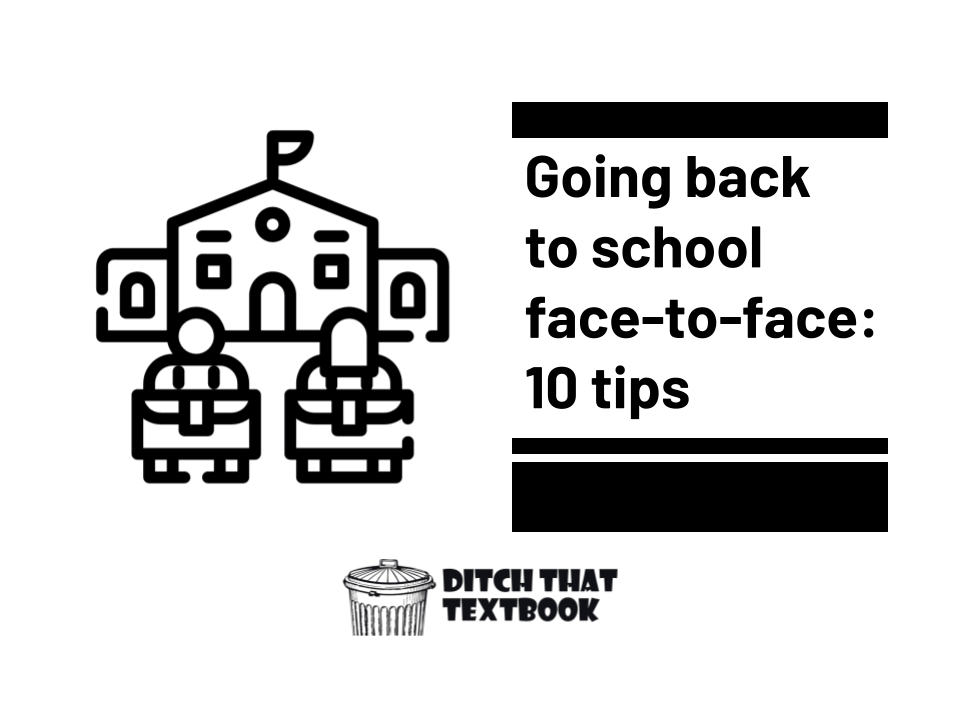
After enduring remote learning, teachers and students are heading back to the classroom. Here are some things to keep in mind.
After more than a year of remote instruction, some schools are going back to school face to face for the first time.
For others, they've been face to face for a while, but the remote instruction experience is still fresh.
For both, there's a big question at hand.
What did we learn from remote learning? And how does it affect how we teach?
I recently polled educators who are undergoing that same transformation -- from remote to face-to-face -- or have already gone through it.
They provided some sage advice.
What's your best advice for going face-to-face after remote learning?
— Matt Miller (@jmattmiller) July 9, 2021
Here's a summary of their thoughts. You can see all of the 200+ replies in this Twitter thread.

1. Offer lots of choice.
When students were at home, many of the mechanisms we use to maintain routine weren't around. Getting back to a sense of routine and structure may be tough. Giving students choices can ease that transition. Plus, it's not just a remedy for getting back into school. Choice gives students agency over their learning!
It's very hard for students to go from a time of little structure, to the rules-based life of school. And who can blame them? Be really explicit about your expectations, chuck your lessons so they don't have to sit still too long. Give them choice and agency as often as possible.
— Michelle Dennis (@michelledennis) July 9, 2021

2. Utilize tech in new ways.
After teaching remotely, many of us have learned new ways to use our technology. Some of us have learned brand new technology! We now have more tools in our instructional toolbelts than ever. When we look at what we want kids to accomplish in class, we can pull out the best tools for the job.
Merge the best parts of remote, hybrid, and face to face learning to make the "new normal" the best it can possibly be for *all*.
— Patrick Hausammann (@PHausEDU) July 9, 2021
Don't abandon tech and the opportunities it affords, meaningfully integrate it and use it only when it enhances possibilities & opportunities.

3. Model procedures.
I love the way Christian Perkins puts this: "Assume nothing; model everything." Clear and explicit modeling of expectations, instructions, etc. has been a part of many classrooms. But as we go back into the classroom face to face, it's especially crucial. Students understand better when they can see it, and when they see us doing what we expect, it can go a long way.
Start Over: Generalization is a tough skill for Ss to achieve. Start over with expectations, procedures… all of it! Assume nothing; Model everything. And, as always, give yourself grace, and extend it to your students.
— Christian Perkins (@MrTeacherCoach) July 9, 2021
Resource: Modeling: Essential for Learning

4. Use daily agendas to keep everyone on track.
Dwight D. Eisenhower once said, "Plans are useless, but planning is indispensable." Knowing where you're going is key. Many students and parents had to work extra hard to make sure everything was covered and completed in remote learning. Daily agendas and routine can go a long way to help.
Take the good of remote learning & incorporate it in f2f learning (eg. daily agendas using a @SlidesManiaSM template, etc). More importantly, in the 1st 2-3 days, establish routines & relationships…get 2 know the students again! The curriculum ‘stuff’ will come later…
— AnnamariaDiBenedetto (@Mme_DiBenz) July 9, 2021

5. Take time to be a trauma responsive educator.
The pandemic was rough on a lot of families in a lot of ways -- medically, financially, emotionally, etc. Learning can happen once students' basic needs are met -- including safety and security, and that includes perceived safety and security. As educators, we can do our best to respond to that trauma that students have endured by taking action.
Building relationships… as always. We’ll have nervous students and staff, some who suffered trauma from the pandemic. #SEL must be a main focus. Folks panic about learning loss, but if you’re anxious & stressed, you’re not learning anyway.
— Vanessa Heller (@Hell2Teach) July 10, 2021

6. Play!
The classroom can be a theater of happiness, laughter, and togetherness in a way that the virtual classroom could not. A little play can go a long way right now! Research is clear on the powerful impact of play on learning, as you can see in Creating a Playful Classroom, the free online course linked below. A smile can make a memory and make learning stick.
Bring all of the energy that couldn't be captured in video chats with cameras off. Laughter, group work, team work, collaboration, giving students time to ask questions and discuss/think/play with the content.
— Paige LaBarr (@PaigeLaBarr) July 9, 2021

7. Build and maintain relationships with families.
This is a crucial key to learning that educators constantly point to. Build relationships with students. But also build relationships with families! Parents have become co-teachers of sorts during the pandemic. Keep that connection and communication going when returning face to face. Students will benefit.
Remember what remote learning taught you, build on the opportunities that now exist because of remote learning and most important build solid relationships with students, parents and the community. ✌🏿🖤✊🏿
— W.V . Law, III M.Ed (@its_wil_law_iii) July 12, 2021

8. Teach kids conflict resolution.
When coming back from remote instruction, students have a lot to reacclimate themselves to. Social interactions are one area -- and an important one. It takes some time to build up communication and empathy skills again. A little guidance in conflict resolution and other areas can be very handy and helpful right now.
There are great suggestions here. I will only add that social interactions are going to be different. How Ss interact is different as well as how they communicate. Spend time handling conflict resolution.
— Erick McCormick (@erickmccormick7) July 9, 2021

9. Practice talking to one another.
Here are those social interactions again! Communication and collaboration are two of the 5 C's and 21st century skills. Not only does it build students' social skills, but it also helps them to see how their peers think and feel. After all of that time in isolation during the pandemic, this can help students ease back into socialization.
Start with speaking and listening standards, get students moving and speaking on different topics and in different ways.
— Free Period Reviews (@FreePeriodTeach) July 14, 2021
Resource: Honing Students' Speaking Skills

10. Build in lots of breaks.
There's only so much the human brain can take at once. Cognitive load is the idea that the brain can only hold so much in its working memory at once. Give the brain some time to consolidate that new learning and store it in long term memory. Plus, breaks where students move are powerful. Physical movement can give the brain a jolt that will improve cognition.
I built in a 15 minute snack and cell phone bathroom break time in the middle of my 90 minute lesson and it saved all of us 🙌🏾
— Lisa Soares (@lisoares9) July 10, 2021

BONUS: Going Back to In-Person Learning by Wesley Glossen
In this post, educator Wesley Glossen offers some tips and activity ideas for teachers making their way back to face-to-face classes. He includes strategies for rules, icebreakers, dealing with parents, dealing with paperwork, and being supportive.
— Wesley Glosson (@teachthisteach) July 9, 2021
For notifications of new Ditch That Textbook content and helpful links:
- like Ditch That Textbook on Facebook
- follow @jmattmiller on Twitter
- check out the #DitchBook community on Twitter
- follow Ditch That Textbook on Pinterest
- subscribe to the Ditch That Textbook YouTube channel!
Interested in having Matt present at your event or school? Contact him by e-mail!
Is Matt presenting near you soon? Check out his upcoming live events!

